Downy Mildew in Grapes: The Invisible Enemy Behind Major Crop Losses – Here is a Solution
What is Downy Mildew Disease?
Downy Mildew is one of the most destructive diseases in grapevines, caused by a fungus-like pathogen known as Plasmopara viticola. It is known to rapidly damage the leaves, inflorescence, and fruits, especially during warm, humid weather. Unlike powdery mildew which stays on the surface, downy mildew penetrates deep into plant tissues, making control extremely difficult if not addressed early.
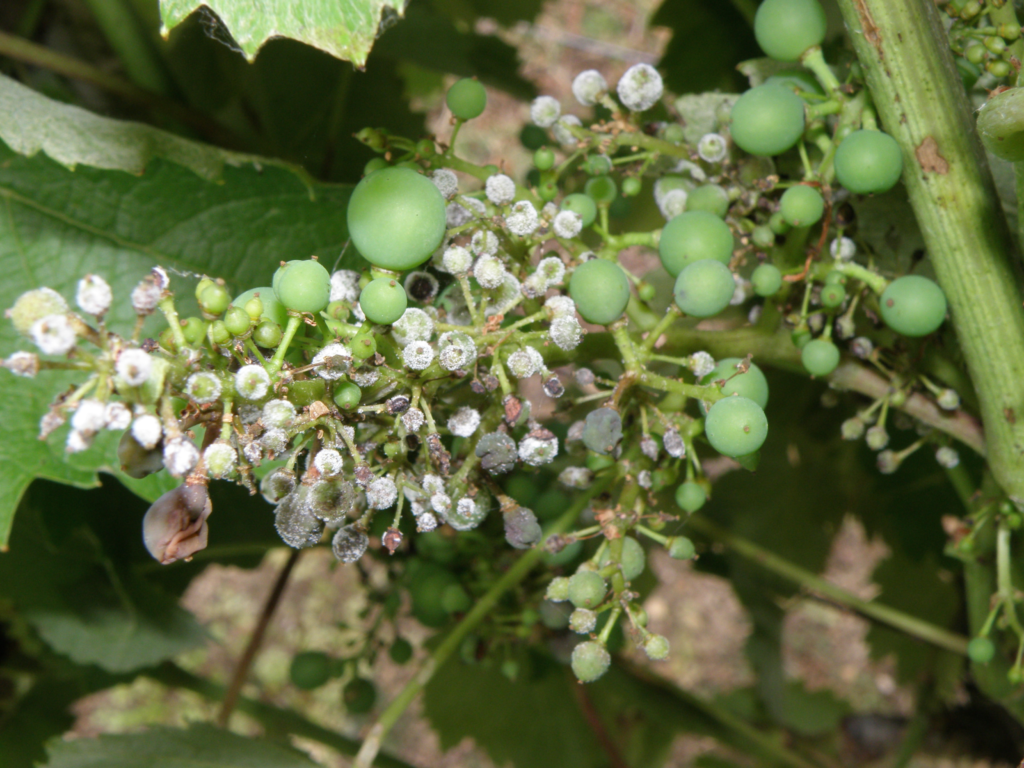
Image credit: DPIRD, Western Australia
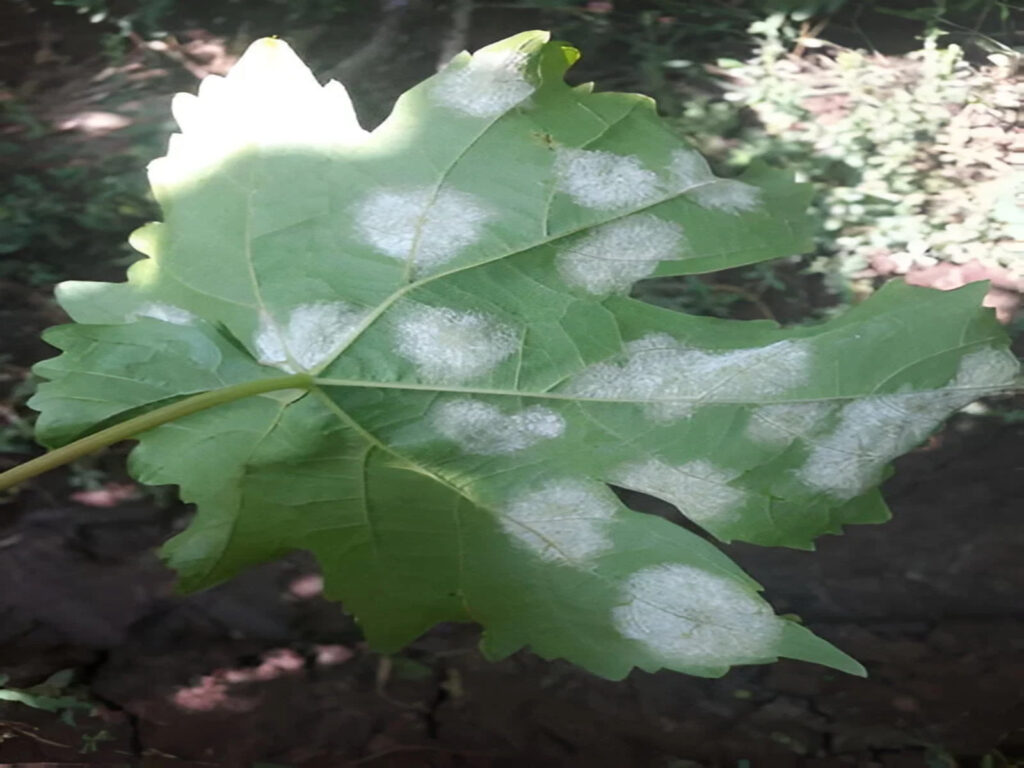
Image credit: Peat Cloud
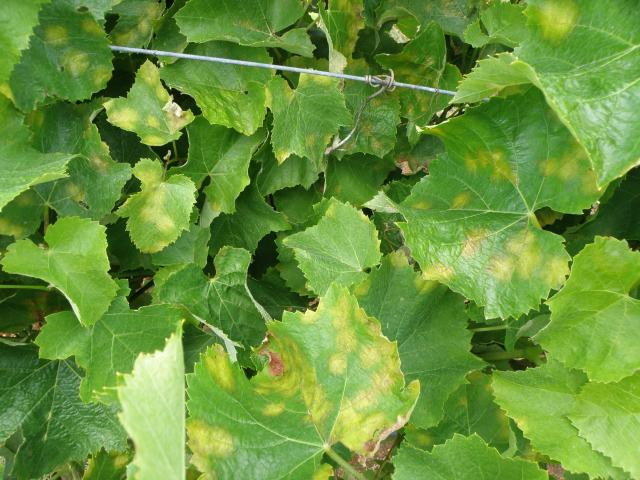
Image credit: DPIRD, Western Australia
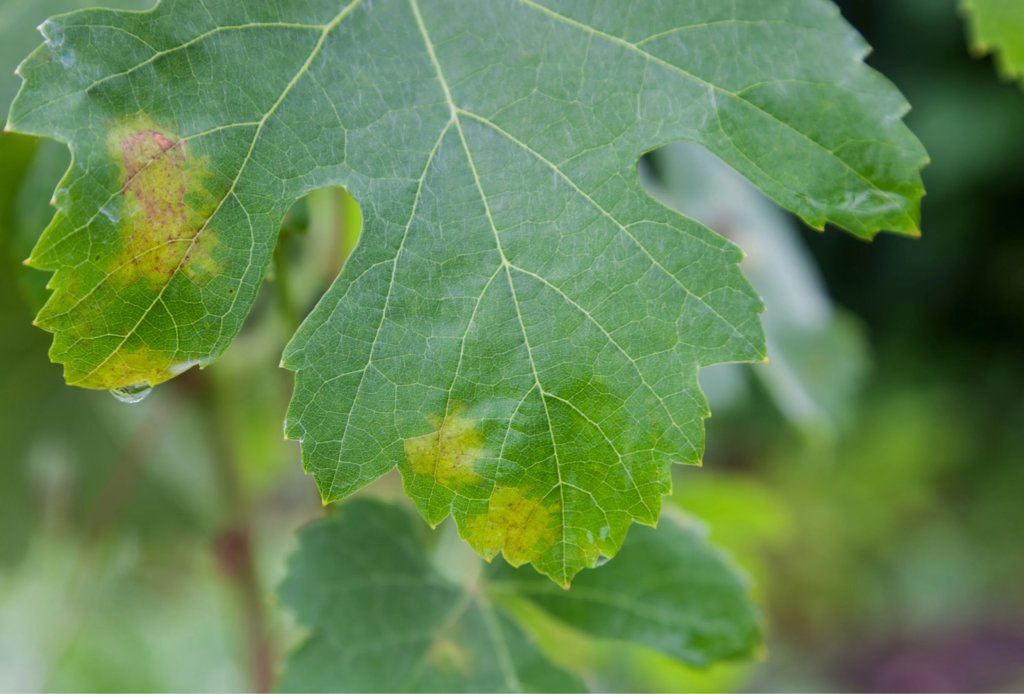
Image credit: Koppert India
Table of Contents
Scientific Name of the Pathogen
- Pathogen: Plasmopara viticola
- Kingdom: Chromista
- Phylum: Oomycota
- Class: Oomycetes
- Order: Peronosporales
- Family: Peronosporaceae
Past Losses due to Downy Mildew in Grapes
- Severe epidemics have wiped out 40–80% of yields in major grape-growing regions like Nashik, Sangli, Solapur, and Telangana.
- In export-grade grapes, even minor infections can make entire batches unfit for export due to residue or cosmetic damage.
- Quality parameters such as sugar content (BRIX), shelf life, and color are all negatively impacted.
Symptoms of Downy Mildew Disease
Symptoms on Leaves
Downy mildew symptoms on grapevine leaves begin as small, yellowish oil spots on the upper surface — often referred to as “oil patches” due to their translucent and greasy appearance. As the disease progresses, these spots enlarge and may merge, forming larger chlorotic areas. The underside of the leaf directly beneath these patches develops a distinctive white, downy fungal growth, which is the sporangial mass of Plasmopara viticola. Infected leaves may eventually turn brown, curl, and fall off prematurely, severely affecting the plant’s ability to photosynthesize. This loss of foliage, if occurring early in the season, can drastically reduce yield and fruit quality.
Symptoms on leaves – Pale yellow leaf spots on upper surface of grape leaf
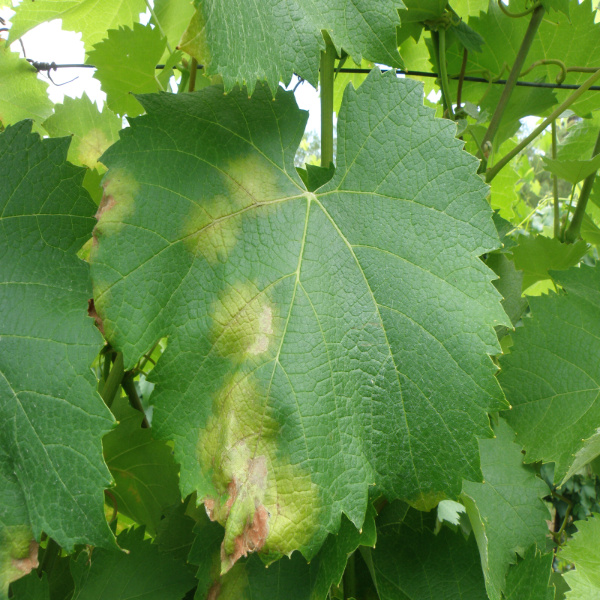
Image credit: DPIRD, Western Australia
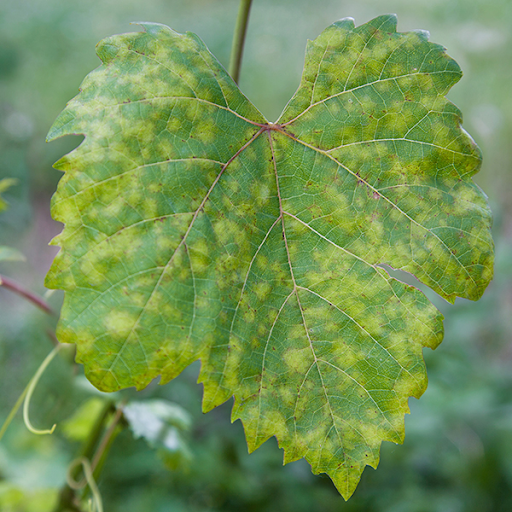
Image credit: Searles Gardening
Symptoms on leaves – White “downy” fungus growth on the underside of infected leaves
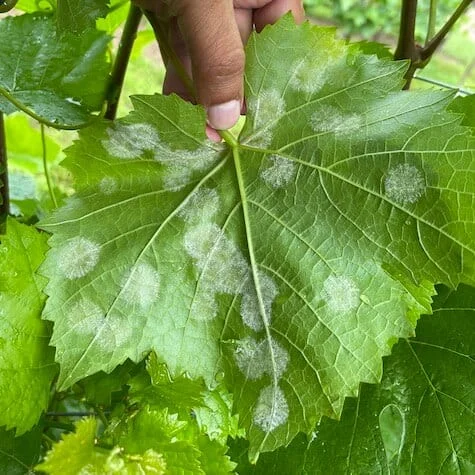
Image credit: Katyayini Krishi
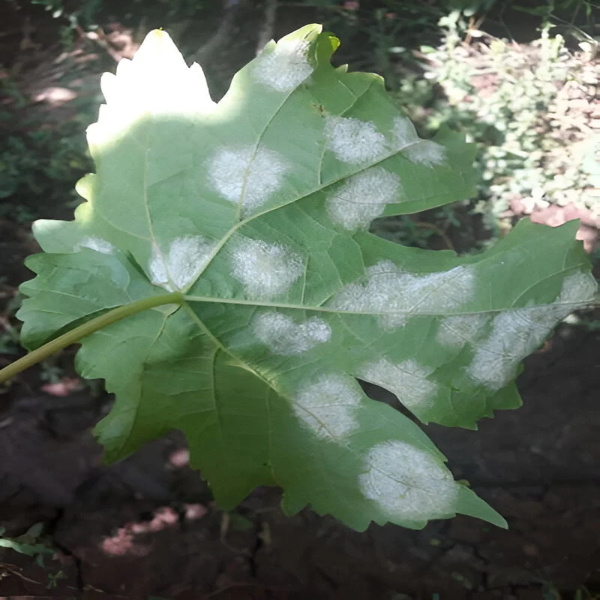
Image credit: Plantix
Symptoms on leaves – White “downy” fungus growth on the underside of infected leaves, the sporangial mass of Plasmopara viticola.
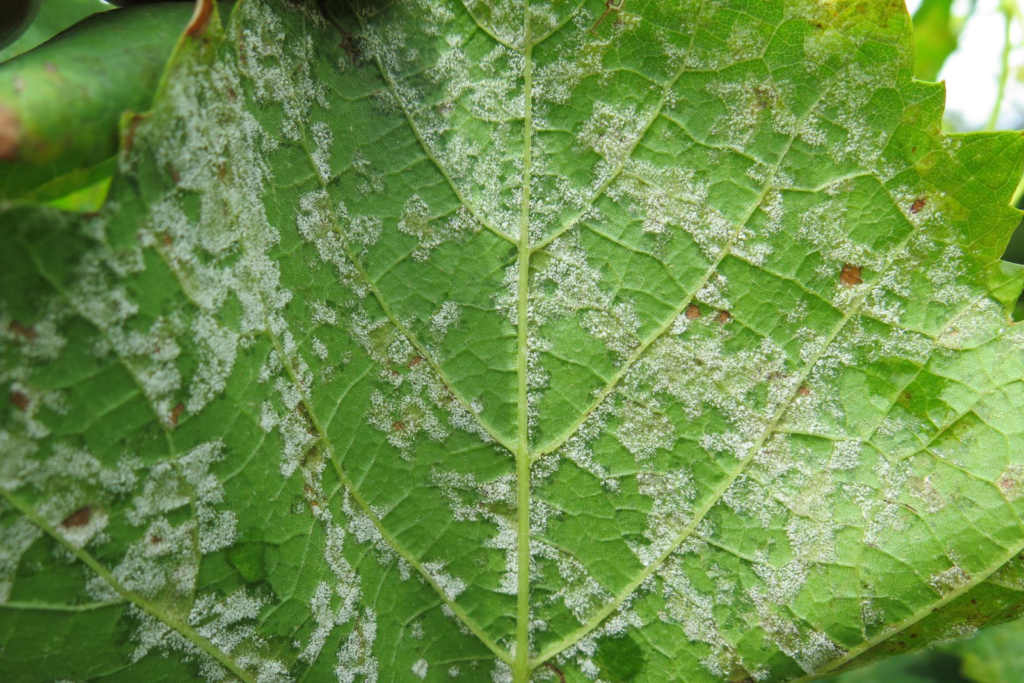
Source: https://bit.ly/3SQvkSC
Symptoms on Twigs, Shoots and Stem
Young, green twigs and shoots are highly susceptible to downy mildew. The infection manifests as elongated, brown to purplish lesions on the surface of tender shoots. These lesions may girdle the stems, leading to wilting and death of the distal parts. In severe cases, the stems become weak, soft, and may collapse, especially under humid conditions. If the stem base is infected, the entire shoot may die back, resulting in poor canopy development and compromised plant structure. The disease can also leave behind scars on matured vines, reducing their productivity in the following season.
Symptoms on Shoots – cottony growth on the surface of the young shoots

Image credit: OMAFRA
Symptoms on Shoot – Downy mildew infection has spread to the shoot causing the oily brownish lesions

Image credit: DPIRD, Western Australia
Symptoms on Inflorescence and Flowers
Inflorescences and flowers are among the most vulnerable parts of the grapevine during the flowering stage. Infected inflorescences rapidly turn brown, appear water-soaked, and eventually dry up. The white downy growth may also be visible on the flower clusters under moist conditions. This early infection causes flower abortion, leading to poor fruit set or complete loss of yield in severe cases. The disease can spread very quickly across the inflorescence under conducive conditions, making early detection and management critical during the flowering phase.
Symptoms on Inflorescence- Dried Flowers and death of bunch due to Infection on flowers
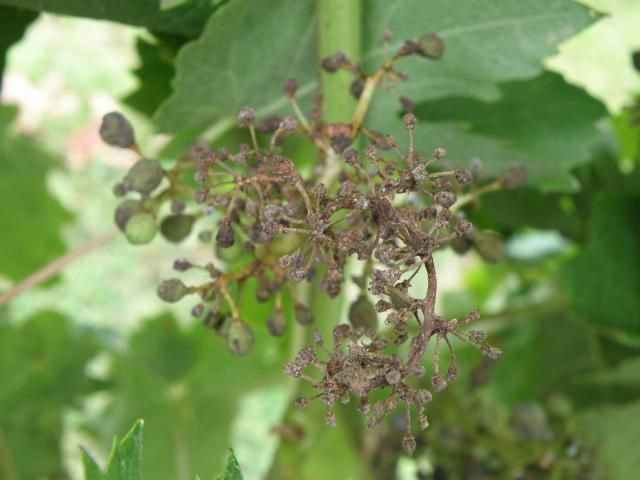
Image credit: DPIRD, Western Australia
Symptoms on Inflorescence – white downy growth visible on the flower clusters
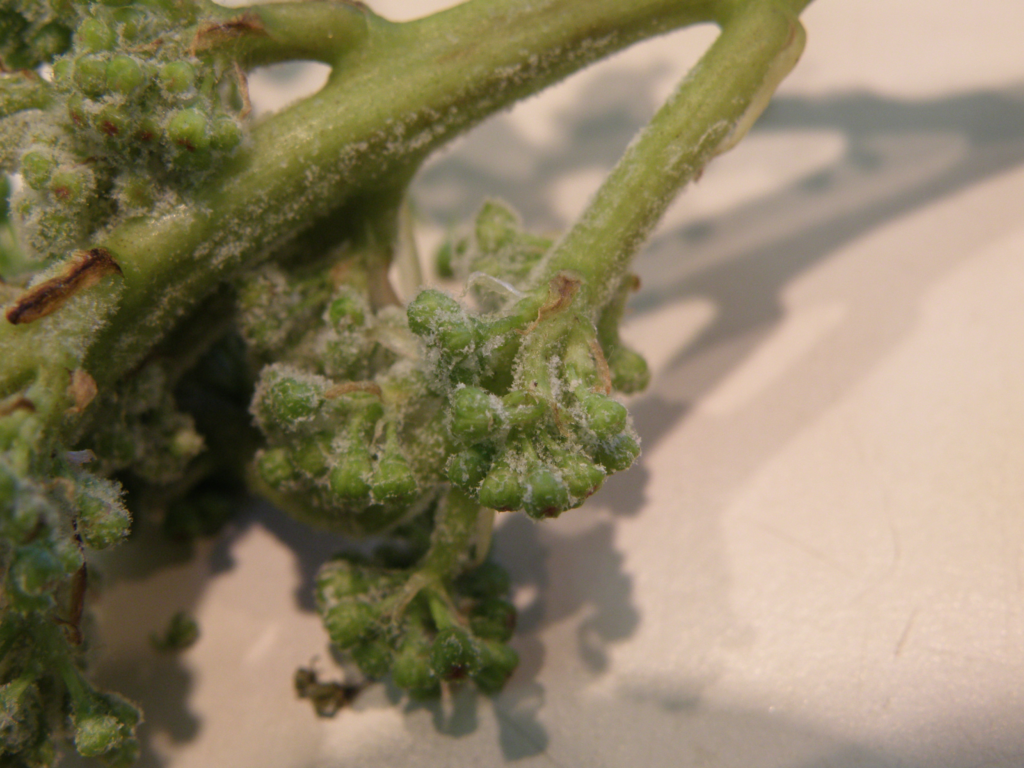
Image credit: DPIRD, Western Australia
Symptoms on Fruits (Berries)
Young grape berries infected by downy mildew show dull green or light brown discoloration, often accompanied by shriveling and collapse of the berry structure. Under humid conditions, a white downy fungal growth appears on the surface of the berries, typically during early development stages. As the disease advances, the affected berries become leathery, deformed, and may drop prematurely or remain on the vine as dry, shriveled mummies(mummified berries). Infections close to harvest render the fruit unfit for market or export, as they lose BRIX quality, firmness, and shelf life.
Symptoms on berries – Mummified berries
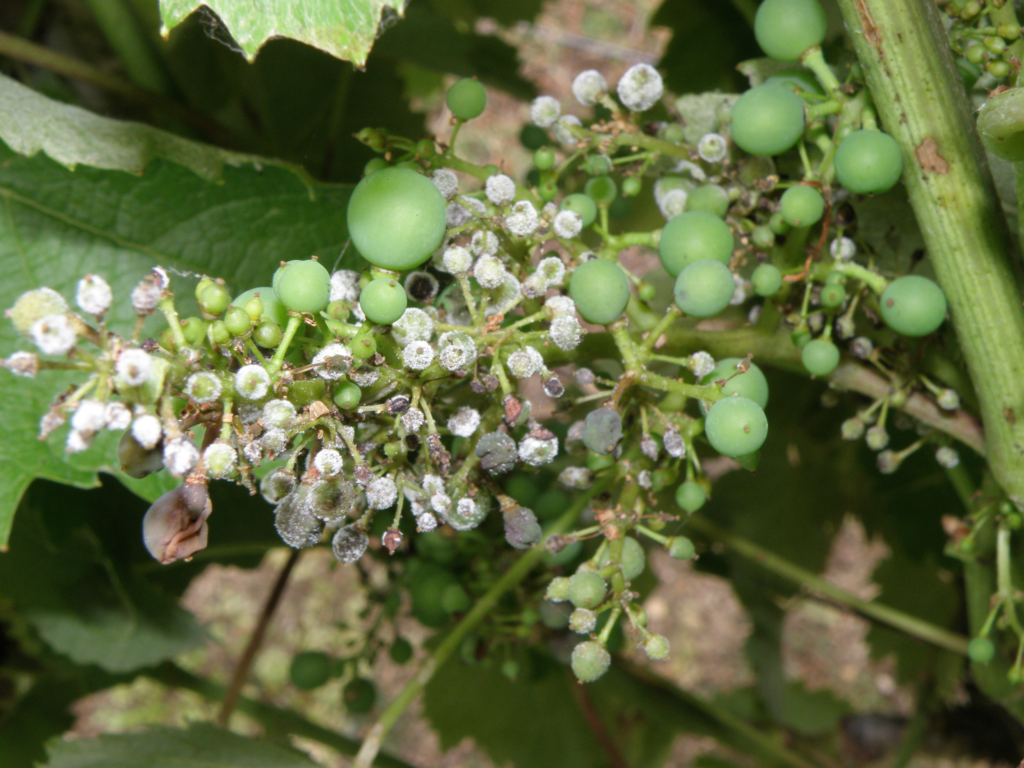
Image credit: agric.wa.gov.au
Disease Cycle of Downy Mildew in Grapes
Downy mildew is an obligate parasite (meaning it requires a living host) and therefore it grows on all green parts of the vine. However, there is one overwintering stage of downy mildew development that is not found on green tissue.
Primary Inoculum (Survival & First Infection)
The primary source of inoculum for downy mildew comes from overwintering oospores, which are thick-walled sexual spores of Plasmopara viticola. These oospores survive for many months in fallen infected leaves, twigs, and plant debris on the vineyard floor, especially in moist and shaded areas. They remain dormant during dry or cold seasons.
It can overwinter in infected leaves and litter in the soil for 3-5 years (possibly up to 10 years).
With the arrival of spring and favorable temperature (10–15°C) and moisture from rain or irrigation, oospores germinate in the soil, forming sporangia, which are the structures that produce zoospores. These zoospores are motile (they swim) and move via water films on plant surfaces.
They infect grapevine tissues through stomata (natural pores) on the underside of young leaves, causing the first visible infections, which usually appear as yellowish oil spots on leaves and downy fungal growth below them. This marks the beginning of the primary infection.
Secondary Inoculum (Spread During Season)
Once the initial infections are established, the pathogen rapidly begins asexual reproduction.
- Sporangia are produced on the lower surface of infected leaves, appearing as white fluffy masses (the “down”).
- Under humid conditions, each sporangium releases multiple zoospores, which are then dispersed by wind, rain splashes, dew, or even insects to nearby healthy plant parts.
These new zoospores infect:
- Nearby leaves
- Twigs and shoots
- Flowers and inflorescences
- Developing grape berries
This is called the secondary spread or secondary infection cycle, and it can repeat multiple times within a season — especially during monsoon or humid periods.
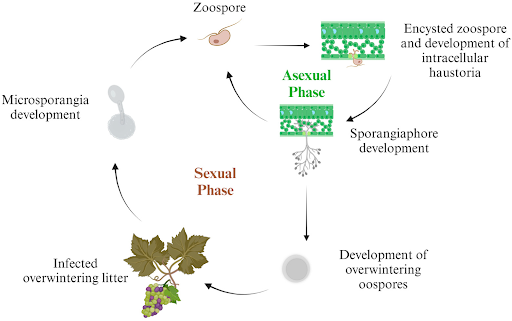
Image or content credit: MDPI – Agriculture Journal
Each new lesion can act as a new center of infection, leading to an exponential outbreak if not controlled early.
End of Season and Survival
By the end of the season:
- Infected tissues drop to the ground.
- Within this plant debris, the pathogen undergoes sexual reproduction and forms new oospores.
- These oospores enter dormancy again, waiting to restart the cycle in the next season.
This makes downy mildew a polycyclic disease, capable of causing many infection cycles in one season — making it extremely aggressive.
Favorable Conditions for Downy Mildew Outbreak
- Humidity: >80% relative humidity is ideal for infection.
- Temperature: Optimal temperature for disease development is around 20-25°C.
- Leaf Wetness: More than 4 hours of moisture on leaf surfaces promotes spore germination.
- Dense Canopy: Blocks airflow and traps moisture.
- Previous Crop Debris: Fallen leaves harbor overwintering spores.
- Poor Drainage: High soil moisture encourages survival stages
Forecast Model (Used by ICAR-NRC Grapes and IMD):
Infection warning is issued when:
- Mean RH > 85% for at least 48 hrs,
- Temperature remains between 10–25°C,
- Leaf wetness or rainfall persists for > 6 hrs/day,
- At least one past infection was observed in the block
If these conditions persist for 48–72 hours — a Downy Mildew Alert is triggered.
Management Tactics for Downy Mildew
Integrated Disease Management (IDM) is the most effective approach. Here’s how:
Cultural Control
- Always ensure early pruning and removal of infected debris.
- Use disease-free planting material.
- Train vines to improve airflow.
- Avoid overhead irrigation during humid periods.
Monitoring and Forecasting
- Use disease prediction models based on humidity and temperature.
- Regular scouting of lower leaf surfaces and inflorescences
Why Chemical Fungicides Eventually Fail
- Pathogen resistance develops with repeated use of systemic fungicides.
- Residue levels in grapes exceed MRL (Maximum Residue Limit), leading to rejection in export.
- Multiple sprays increase input cost
Huntin’s simple and sure-shot solution for Downy mildew
- A Proven Organic Protocol for Grapevine Health and Disease Prevention
- Safe for use during any crop stages
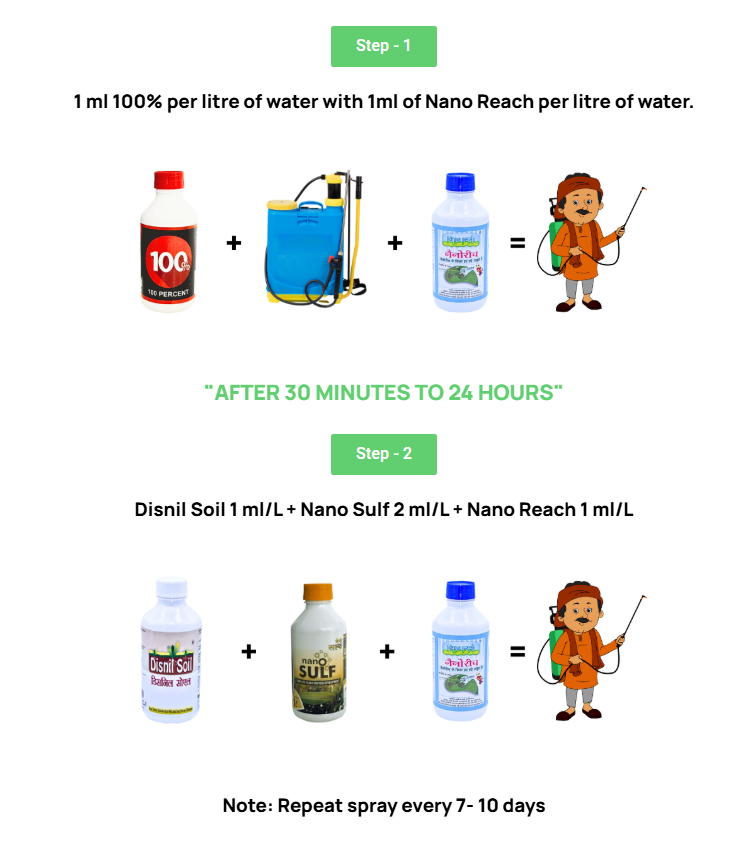
Step 1: First Protective Shield
When to Use: Begin application as a preventive measure or at the very early stage of disease appearance.
Why: This step helps neutralize spores
SPRAY:- 100% : 1 ml / lit of water + Nano reach : 1 ml / liter of water
Spray precautions
- Ensure uniform spray coverage on both upper and lower leaf surface and whole plant
- Also spray on ground surface surrounding vine stem because fallen debris on ground hibers oospores (primary source of inoculum) in it
- Apply during early morning or late afternoon.
Step 2: Strengthening Defense & Root Immunity
after 30 minutes to 24 hrs. after Step 1
Spray: Disnil Soil – 1 ml / liter of water + Nano Sulf – 2 ml / liter of water + Nano Reach – 1 ml / liter of water
Spray precautions
- Ensure uniform spray coverage on both upper and lower leaf surfaces and the whole plant
- Apply during early morning or late afternoon
Soil Application of – Seed Grow ++ @ 1 Litre per Acre. Repeat this application at intervals of every 15 days. Seed Grow++ promotes a healthy root system and efficient mobilization and uptake of nutrients, which strengthens the plant’s natural immune system to fight against disease.
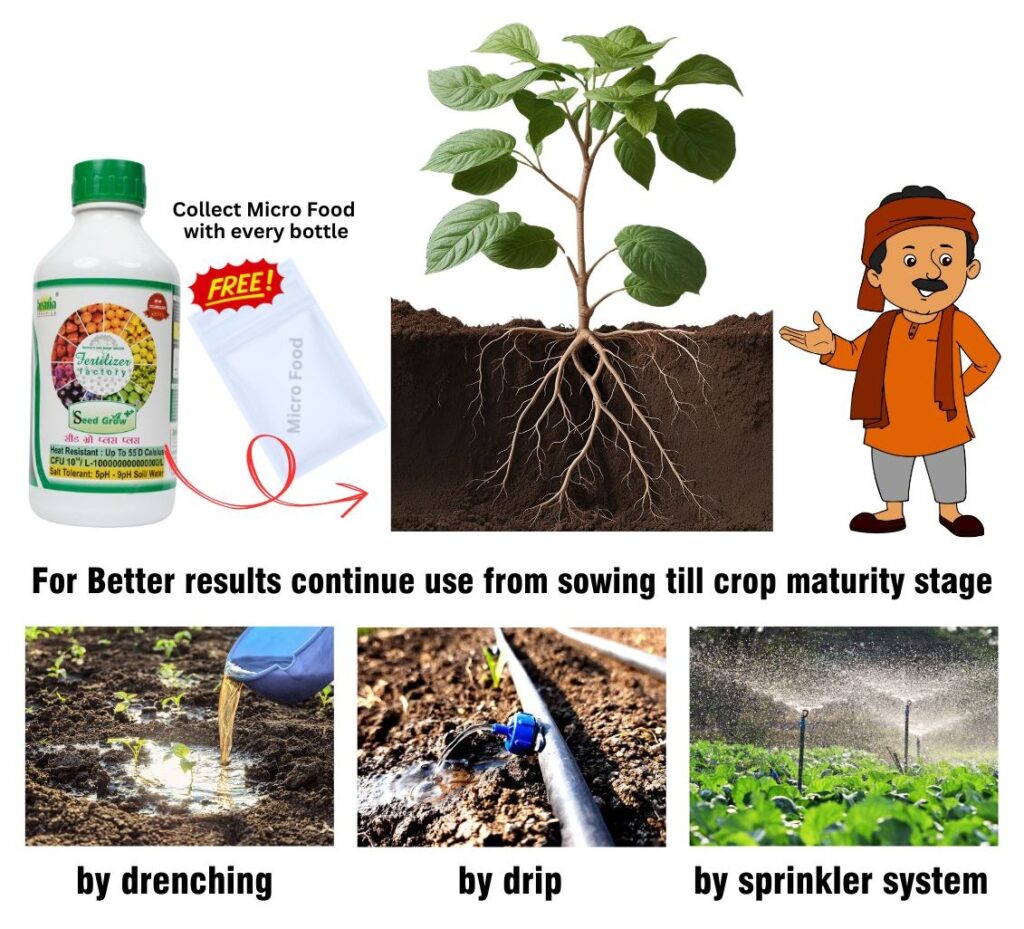
Reapplication Schedule
To maintain control during high-disease-pressure seasons (monsoon or post-monsoon), repeat Step 1 and Step 2 every 7–10 days.
Why Repetition Is Crucial:
- Downy mildew fungus life cycle continues every 7–10 days under optimal conditions.
- Repeated sprays break the fungal life cycle at every stage – spore, mycelium and resting body.
- Ongoing sprays ensure new plant growth is protected.
Why This Protocol Works:
Uses natural and plant based bio components, safe for beneficial insects
No resistance development
Chemical residues free — export-friendly and eco-safe
Enhances nutrient uptake and photosynthesis with nano-sulfur support
A Brief Product Details :
100% – An organic plant extracts having anti-fungal & anti bacterial properties 100 % Percent – Huntinorganics
Nano Reach – A 100% pure silicone-based non-ionic surfactant, spreader, adjuvant that increases stomatal infiltration and spreading of the active ingredient Nano Reach – Huntinorganics
Nano Sulf – A sulfur- and potash-based nano formulation that acts as nutrient, contact fungicide, photosynthesis enhancer.
Disnil soil – Bio fungicide consortium containing Trichoderma v., Trichoderma h., Pseudomonas f., Bacillus s.
Seed Grow ++ is a synergistic combination of highly effective 12 biological strains of Bacteria and Endo mycorrhizae that solubilize and mobilize the plant macro and micronutrients such as N, P, K, Ca, Mg, S, Si, Zn, etc that improves nutrient balance in plant, effective root development, stress management, improvement of soil structure.
Balanced nutrition is the most important factor in plants to fight against any disease.
For more details on grapes’ diseases & insect pests and their control, please visit – Huntin Organics


